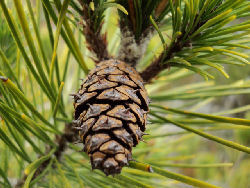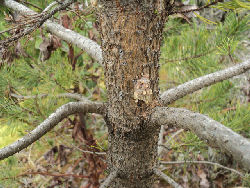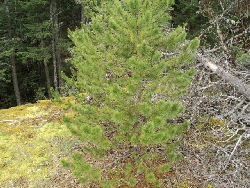


|
|
Practical ecological knowledge for the temperate reader. |
 |
|  |
"Beach pine was widely employed medicinally by several native North American Indian tribes who used it especially for its antiseptic and healing properties on wounds, infections etc, and also for its beneficial effects upon the chest and lungs(257). It is little, if at all, used in modern herbalism." [PFAF]
"It can be used fresh or dried. It is mashed into a pulp and made into cakes then baked(94). Harvested in early spring, the taste is not unpleasant, but it develops a strong taste of turpentine as the season advances(2). The inner bark is ready to harvest when the male cones are producing pollen(257). A famine food, it is only used when all else fails." [PFAF]
Harvesting: "The outer bark or periderm is a protective layer, which encloses the delicate vascular tissues underneath. The vascular cambium is sandwiched between the outer bark and the woody stem. Divisions of the vascular cambium produce secondary xylem and secondary phloem. Secondary xylem is produced toward the interior of the cambium and eventually develops into wood. The secondary phloem is produced by divisions toward the exterior of the cambium and, during a short time period in late May or early June, the tissue is thick enough to be scraped in strips off the trunk of the tree once a section of the bark is removed." Bark
Preparation: "Cooking can result in the breakdown of sugars into a more digestible form, increasing palatability and digestibility, and leaching of tannins, resins, lignans, terpenes, waxes and other secondary metabolites which are distasteful. It appears that cooking lodgepole pine cambium with a small quantity of water died leach out some distasteful components but it also leeched the sweetness...". "...pit-cooking of lodgepole pine cambium does not seem to be common practice. There is no evidence to suggest that lodgepole cambium was cooked in any manner other than smoking for drying. There really was no need to cook such a food, which was delicate in form and already palatable when raw, with no indigestible sugars. taste testing prior to harvesting, eliminated tannin-heavy samples." Bark
"...the cambium strips were laid out on wooden racks in crisscross format, creating a woven mat of bark strips. Strips of inner bark were left to dry in the sun for one to three days, or were dried over a fire...the substance will retain for quite a while much of its original spicy taste" Bark
Bread
"The Indians cut the trees down and strip out the inner bark. This is broken into pieces by the patient squaws who mash it in water into a pulp which they mold into large cakes. Then a hole is dug in the ground and lined with stones, and a fire kindled. When the stones are hot, the embers are removed, and the cakes packed in with leaves of the Western Skunk Cabbage between. A fire of damp moss is built on top, and the baking takes an hour or more. Then the cakes are laid on slat frames and smoked for a week in a close tent. Now they are ready to be put away for future use or to carry in canoes or on ponies to distant places."
"This "hard bread" is prepared for use by breaking it in pieces and boiling them until soft. The pieces are skimmed out and laid on the snow to cool. "Ulikou" fat is used on this strange Alaskan bread as we use butter." [EWP]
Fiber
"Important pulpwood in some loeals, minor in the others (Isenberg 1980, Parharn and Gray 1990)." "Fiber dimensions (Isenberg 1980):" "Fiber length av. 3.1 mm" "Fiber width av. 35-45 Um" [Sisko FA]
"Nutritional Values Based on 100 g of Raw Lodgepole Pine Cambiumb; Proximates Energy 51 kcal Moisture 87.6 g Fat 0.61 g Protein 6.25 g Crude fiber 1.41 g Total carbohydrate 10.6 g Sugars Total sugar 6.7 g Fructose 4.0 g Glucose 2.8 g Sucrose < 0.1 gc Vitamins Vitamin D < 10 IUc Vitamin C < 1 mgc Thiamine < 1 mgc Riboflavin < 1 mgc Niacin 0.30 mg Retinol 0 IU Beta carotene 0 IU Minerals Potassium 191 mg Phosphorus 33.7 mg Magnesium 19.4 mg Calcium 1.11 mg Iron 0.27 mg Zinc 0.26 mg" "bValues are derived from one pooled sample from cambium harvested from 17 trees (see text). cValues not detected below this level." Bark
"Currently, in commercial resin-tapping operations, pine oleoresin is tapped from living trees (Langenheim 2003) by means of a repeated wounding process (bark streaking method (Rodrigues et al. 2008) or bark chipping (Tumen€ and Reunanen 2010), which removes the bark and tissues beneath it, followed or not by a chemical stimulant application." Resin "Once collected, the crude oleoresin conversion into gum turpentine and gum rosin is carried out by steam distillation (Rezzi et al. 2005). Then, these by-products are processed for subsequent use in fabrication of diverse industrial products. "Resin
"A pitch obtained from this tree is used for waterproofing canoes, baskets, shoes etc and as a glue(64, 99, 226, 257). It has also been used to preserve wood, baskets etc(257). The pitch is not a commercially important crop(64). Oleo-resins are present in the tissues of all species of pines, but these are often not present in sufficient quantity to make their extraction economically worthwhile(64). The resins are obtained by tapping the trunk, or by destructive distillation of the wood(4, 64). In general, trees from warmer areas of distribution give the higher yields(64). Turpentine consists of an average of 20% of the oleo-resin(64) and is separated by distillation(4, 64). Turpentine has a wide range of uses including as a solvent for waxes etc, for making varnish, medicinal etc(4). Rosin is the substance left after turpentine is removed. This is used by violinists on their bows and also in making sealing wax, varnish etc(4). Pitch can also be obtained from the resin and is used for waterproofing, as a wood preservative etc." [PFAF]
"...oleoresin-derived terpenes can be used as renewable and environmentally friendly" insecticides. "...a-pinene, limonene, and camphor are natural insect repellents." Geraniol is an effective mosquito repellent. Carvacrol, reported to be responsible for the insecticidal activity in a different plant, is also found in pine essential oils. Resin
"Thrives in a light well-drained sandy or gravelly loam(1, 11). Dislikes poorly drained moorland soils(1). Tolerates water-logged soils(81). Succeeds in exposed maritime positions(49, 81). Established plants tolerate drought(200). The coastal form of this species is a very fast growing tree, especially when young..."(185)"...New growth takes place from mid-April until early July(185)." Trees 600 years old are recorded(229). "Extensively cultivated for timber in N. Europe(50, 200), this is an aggressive colonizing species that can form huge pure stands following a forest fire or clear-felling an area for timber(226)." Trees can be shrubby if grown on poor sites(200). "Plants are strongly outbreeding, self-fertilized seed usually grows poorly(200). They hybridize freely with other members of this genus(200). This species hybridises in the wild with P. banksiana where their ranges overlap(226). Trees come into flower...between 6 and 10 years(229). Good seed crops...every 1 - 3 years(229). The cones are 2 - 5cm long(82)...many of the cones will remain unopened on the tree, preserving the vitality of the seeds until they are stimulated to open by excessively hot weather or a forest fire(82, 229). Plants in this genus are notably susceptible to honey fungus(200)."[PFAF]
Ectomycorrhizal Fungi
Diseases
Mountain Pine Beetle, Resin, and Fires
"Pines such as lodgepole pine (Pinus contorta var. latifolia) that have little constitutive monoterpene variation and a generally low flow of resin in response to Dendroctonus attack are vulnerable to infestation by these bark beetles. In fact, heavy infestation often leads to more than 90% mortality where lodgepole pine is a pioneer or early-successional, fire-adapted species (Chapter 2). Nebeker et al. (1995), however, showed that total flow of resin from lodgepole pine is influenced by the interaction of wound size, tree diameter, and whether the tree is diseased. Generally, resin flow was greater from larger wounds and larger trees as well as from trees diseased with mistletoe, blister rust, and root rot. This increased flow of constitutive resin was important in resistance to bark beetles. However, Raffa and Berryman (1987) hypothesized that beetle epidemics actually favor reestablishment of this pine. Epidemics produce many dead trees, which are then susceptible to large-scale fires. Lodgepole pine has a serotinous cone, that is, resin holds the seeds in the cone until the resin melts during the fire. Following fire, seeds are so abundant that they often result in even-aged, pure stands of this pine." [Langenheim PR]
"Lodgepole pine (Pinus contorta) under attack by mountain pine bark beetles (Dendroctonus ponderosae) near Bend, Oregon, USA. When bark beetles bore into the trunk, they sever resin ducts or resin cavities, allowing resin, which is stored under pressure, to flow into the bored hole and out onto the trunk (where it is visible in this photograph as lightcolored areas on the bark). The terpenoid-rich resin serves as a chemical and physical barrier to further beetle penetration." [Rosenthal HerbV1]
Fire Regime:
"Pinus contorta (lodgepole pine) and P. banksiana (jack pine) also have a relative thick bark capable of surviving repeated scarring from surface fires, they also bear slow maturing cones that remain in the canopy for up to 25 years. In the latter species the resin bond sealing the cone scales melts at 60oC, releasing many of the heat resistant seeds. The seeds can even withstand temperatures of 150oC for 30-45 sec and 370oC for 10-15 sec, an important survival trait whcn combustion in coniferous forests occurs at 350oC." [Wickens, EB]
"It is best to sow the seed in individual pots in a cold frame as soon as it is ripe if this is possible otherwise in late winter. A short stratification of 6 weeks at 4oc can improve the germination of stored seed(80). Plant seedlings out into their permanent positions as soon as possible..."(11), between 5-30 and 10-90cm(200)(k), "...and protect them for their first winter or two(11)....So long as they are given a very good weed-excluding mulch they establish very well(K). Larger trees will check badly and hardly put on any growth for several years. This also badly affects root development and wind resistance(200). Cuttings. This method only works when taken from very young trees less than 10 years old. Use single leaf fascicles with the base of the short shoot. Disbudding the shoots some weeks before taking the cuttings can help. Cuttings are normally slow to grow away(81)."[PFAF]
Pinaceae - Pine Family
"Stem: young crown conic, mature often rounded or flat; branches ± whorled in young plants; young bark smooth, mature furrowed; bud ± conic, generally resinous.
Leaf: generally 2.5–35 cm, generally sessile, in bundles of (1)2–5; bundles 1 in axils of alternate, awl-like bracts, base in a sometimes deciduous, scaly sheath of bracts, generally persistent several years.
Seed cone: often whorled, generally maturing, opening 2nd year, persistent on stem or not; stalk 0 or < 16 cm; bract included, fused to scale at least basally, minute; scale tip reflexed, elongated 3–7 cm or often with a rounded or angled, often prickled knob < 3 cm.
Seed: coat hard, woody or not."
2n=24.
"94 species: northern hemisphere. (Latin: pine) Pinus pinea L., stone pine (leaves 2 per bundle, 10–30 cm; seed cone 8–15 cm, maturing in 3 years) cultivated in Europe for over 6000 years for edible seeds (pine nuts), reportedly naturalized in San Francisco Bay Area, northern Channel Islands."
"Unabridged references: [Millar & Critchfield 1988 Madroño 35:39–53] "
"Unabridged note: Morphological, genetic study of relationships among Pinus jeffreyi, Pinus ponderosa, and Pinus washoensis indicates that the taxa should be classified as 2 species, Pinus jeffreyi and Pinus ponderosa, and that the latter comprises three vars.: Pinus ponderosa var. pacifica (new taxon), Pinus ponderosa var. ponderosa, and Pinus ponderosa var. washoensis (new combination)." [Jepson]
Local Species;
KEY
1. Needles 2 or 3 in a bundle.
2. Needles in bundles of 3, 12-20 cm long..........................Pinus ponderosa
2. Needles generally in bundles of 2, 2-6 cm long.
3. Cones spreading at right angles or reflexed, the scales armed with prickles...............................Pinus controta (2 varieties)
3. Cones directed towards the apex of the shoot, strongly incurved or divergent, the scales unarmed or armed with minute prickles..................Pinus banksiana
1. Needles usually 5 in a bundle.
4. Cones long-stalked, 15-25 cm long, 6-9 cm thick at maturity; cone scales thin and flexible; seeds prominently winged..........................Pinus monticola
4. Cones sessile or subsessile, 5-25 cm long, cone scales thick, woody, and sometimes remaining closed, seeds wingless or wings short and remaining attached to scale.
5. Cones 8-25 cm long, opening at maturity; scales light brown, thinned somewhat toward the tip...............................Pinus flexilis
5. Cones 5-8 cm long, remaining closed and tardily shedding the seeds at maturity; scales purplish, becoming thickened rather than thinnish toward the tip....................................Pinus albicaulis [IFBC-E-flora]
Pine - Pinus spp.
Parts Used: “Pitch and dried needles.” MPPW
Preparation: “Pitch or resin in salve, Method B; the tea, standard infusion, 2 to 4 ounces, up to three times a day, but not for more than several days.” MPPW
Herb Uses: “The salve is used as a stimulating dressing for splinters, foreign-body responses, and superficial, pus-forming infections. A piece of the resin can be chewed as a simple expectorant, and the tea is a pleasant diuretic and expectorant, although extended use can irritate weak kidneys. New-growth spring needles, shorter, juicier, and lighter-coloured, are a good source of vitamin C.” MPPW
Pinus brutia or Other Pinus Species
"An essential use of pine is for the resins and tars, which were strategic for building wooden ships. The best-known example of pitch in shipbuilding is the construction of the ark in Genesis 6:14 by Noah, who was told to “cover it inside and out with pitch” ..." [BiblePlants]
Propagation
Pine Pinus spp.
Collecting Seeds: "If possible, collect the cones just before they open, and dry them to
free the seeds. Cones of a few pine species are held together by resin that has a high melting point, and they will germinate best after fire melts the resin and releases the seeds. Some species of pine
produce good crops annually, others only periodically. Pine seeds have a long storage life - five to
ten years is not unusual, as long as they are kept cool and dry."
When to Plant: "Plant them in the fall or after a period of stratification."
Breaking Dormancy: "Like those of most conifers, pine seeds will often germinate well
without any treatment, but chilling them for six weeks before planting at 34oF to 40oF (1oC to
4oC), or planting them in the fall will result in more complete germination. For seeds grown in the
south, a shorter stratification period will be sufficient, but such seedlings will be more frost
tender then those raised from northern-grown seeds." [NSSH bubel]